

The next steps in classroom conversation orchestration – emergent math. I’m currently rereading Five Practices for Orchestrating Productive Mathematics Discussions by Smith and Stein (2011) as part of a book study with a school.
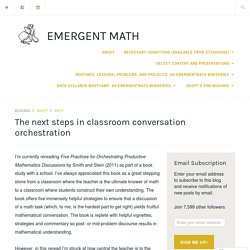
I’ve always appreciated this book as a great stepping stone from a classroom where the teacher is the ultimate knower of math to a classroom where students construct their own understanding. The book offers five immensely helpful strategies to ensure that a discussion of a math task (which, to me, is the hardest part to get right) yields fruitful mathematical conversation. The book is replete with helpful vignettes, strategies and commentary so post- or mid-problem discourse results in mathematical understanding.
However, in this reread I’m struck at how central the teacher is to the discussion itself. The teacher rarely recedes into the background, allowing for students to drive the discussion. It almost never happens naturally. In every one of these sleeves was an index card with these written on it. 5 Must-Have Math Talk Resources. “I want noise and plenty of it–productive, purposeful, and meaningful noise–from everyone, students and teachers alike.”

Christine Moynihan, Math Sense I have, quite possibly, the best job ever. I am a K-5 math interventionist, which means I pull small groups of students all day, every day. When it comes to teaching math, I found out a long time ago that it is much more powerful for me to listen than to talk. Bottom line, the person doing the talking is the one doing the learning, so our students should be talking more than us. This post contains affiliate links, which simply means that when you use my link and purchase a product, I receive a small commission.
Can you spot the signs of a great classroom discussion? □… To create articulate learners we need to model effective oracy. Check out this awesome talk tool from □□… Matthew Arend sur Twitter : "Couldn’t help but notice this handy dandy reminder posted on the corner of students’ desks. If we want students to be accountable with their talk, we must share ways for it to occur. Nice work @suzetteluthi! #mccluremarshals… Encouraging Academic Conversations With Talk Moves. Mathematical Routines. Limiting “Teacher Talk,” Increasing Student Work! “Wah waah wah waah wah wah…” We all know the famous muted trumpet of adults in Charlie Brown’s world, especially their teacher, Miss Othmar.
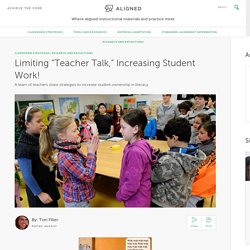
After five years teaching elementary school, I’m confident that I’m not boring my kids to sleep but I do wonder if I strike the right balance between “teacher talk” and student work. Research has long supported the idea that students benefit from “doing.” Regular practice with reading and re-reading increases comprehension and fluency (National Reading Panel, 2000), as well as builds vocabulary and knowledge (Cunning & Stanovich, 1998). Students also need ample time to connect reading and writing to speaking and listening, integrating their literacy skills (see Appendix A).
This is especially important for younger children and English Language Learners, whose oral language far outpaces the ability to read and write (Fisher, Frey, & Rothenberg, 2008). 9 Strategies for Encouraging More Students to Talk in Class. While it is possible to learn by listening, I’ve found that oral participation leads to greater gains in student literacy and engagement.
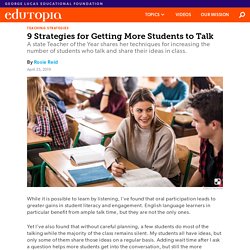
English language learners in particular benefit from ample talk time, but they are not the only ones. Yet I’ve also found that without careful planning, a few students do most of the talking while the majority of the class remains silent. My students all have ideas, but only some of them share those ideas on a regular basis. Math Talk 101. This fall, after switching to our first new math program in over 20 years, we were told that Math Talk was an important component of the program.

My first thought was — "Sounds great! How Learning Happens: Encouraging Academic Conversations With Talk Moves. Sentence starters that students use to join a class discussion encourage both academic thinking and social connectedness.
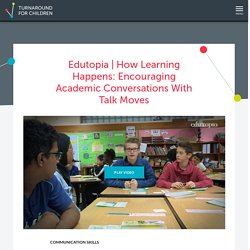
Teachers at King Middle School in Portland, Maine, make these sentence starters easily accessible by taping a talk moves printout to students’ desks. This video is part of Edutopia’s “How Learning Happens” series, which explores teaching practices grounded in the science of learning and human development. Edutopia developed this series in collaboration with the National Commission on Social, Emotional, and Academic Development, with support from the Chan Zuckerberg Initiative; with special thanks to the Science of Learning and Development Initiative, Turnaround for Children, Learning Policy Institute, American Institutes for Research, and EducationCounsel. Back All Videos. "Talk moves" are sentence starters that help students join a discussion, or invite their peers into a conversation. So simple, yet powerful! #HowLearningHappens…
Why students need more 'math talk' Test scores, school report cards and Facebook posts complaining about homework problems often drive critiques of how math is taught in schools.
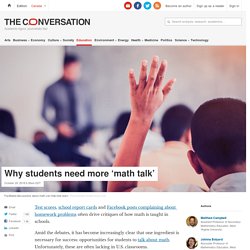
Amid the debates, it has become increasingly clear that one ingredient is necessary for success: opportunities for students to talk about math. Unfortunately, these are often lacking in U.S. classrooms. We are both math education researchers. While we focus on different levels of the K-12 span, a common theme across our work is the role of talk in math classrooms – what talk can sound like, how talk impacts student learning, and how teachers can support math talk. Why Kids Need More Talk Time in the Classroom. Sometimes, for the sake of classroom management, we spend so much time trying to manage noise level that we forget that talk time in the classroom is actually an important element of learning.
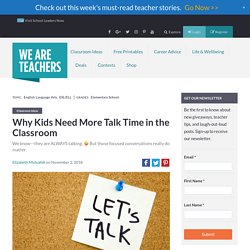
In fact it’s really important. Here are four reasons why, followed by tips to make space for learning conversations in your classroom. 1. 10 Fun Alternatives to Think-Pair-Share. All learners need time to process new ideas and information. They especially need time to verbally make sense of and articulate their learning with a community of learners who are also engaged in the same experience and journey.
In other words, kids need to talk!! Problem is, sometimes it’s hard to stay on subject without a little guidance. That’s why structured discussions really work best with children, regardless of their maturity level. Math I Session 5 Never Say Anything a Kid Can Say Article. Limiting “Teacher Talk,” Increasing Student Work! Questioning and Vocabulary Supports That Inspire Language-Rich Mathematics. How Kids Benefit From Learning To Explain Their Math Thinking. 10 Fun Alternatives to Think-Pair-Share. How to Have an Equitable Class Discussion. These patterns can be self-perpetuating, and they can discourage learning.

Students who are called on over and over may come to view their perspectives as the right perspectives. At the same time, students who are not called on often may begin to perceive their teachers as unfair — and become even less likely to contribute. Establishing inclusive, equitable norms of participation from the start is key. "It's absolutely essential to figure out a way of managing who's speaking when, who's taking turns, in any kind of seminar discussion," says Harvard lecturer Timothy Patrick McCarthy, who teaches a course called Stories of Slavery and Freedom and who strives to make his class discussions equitable from day one.
Week One – Talking Points & Math Mindset. Teaching Your Students How to Have a Conversation. I was recently in a third grade classroom and was struck by the presence of rules that were posted for how to have a conversation.
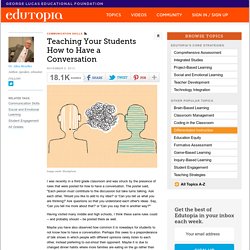
The poster said, "Each person must contribute to the discussion but take turns talking. How Kids Benefit From Learning To Explain Their Math Thinking. Math teachers of older students sometimes struggle to get students to explain their thinking with evidence. It’s hard to get kids in the habit of talking about how they are thinking about a problem when they’ve had many years of instruction that focused on getting the “right answer.” That’s why educators are now trying to get students in the habit of explaining their thinking at a young age. The Teaching Channel captured kindergarten and first grade teachers pushing students to give evidence for their answers in situations where there are several ways to think about a problem. Pattern recognition is a fundamental part of mathematics and kindergarteners are not too young to notice, compare and describe simple patterns. How to Talk Math With Your Kids. Engaging All Students in Mathematical Discussions.
Teachingchannel. 8 ways teachers can talk less and get kids talking more. If you do fewer teacher-directed activities, that means the kids will naturally do more talking, doesn’t it? Not necessarily. I have often found myself talking almost constantly during group work and student-directed projects because I’m trying to push kids’ thinking, provide feedback, and help them stay on task. Strategies for Discussion. Over the past 15 years, the field has begun to tackle the problem of providing teachers with guidelines and tools to support the facilitation of productive classroom discussions. Scaffolding Student Skills for Productive Classroom Discussions. By Jackie A. Walsh. Teaching Students To Listen And Respond In Academic Discussions.
Practical Ways to Develop Students’ Mathematical Reasoning.